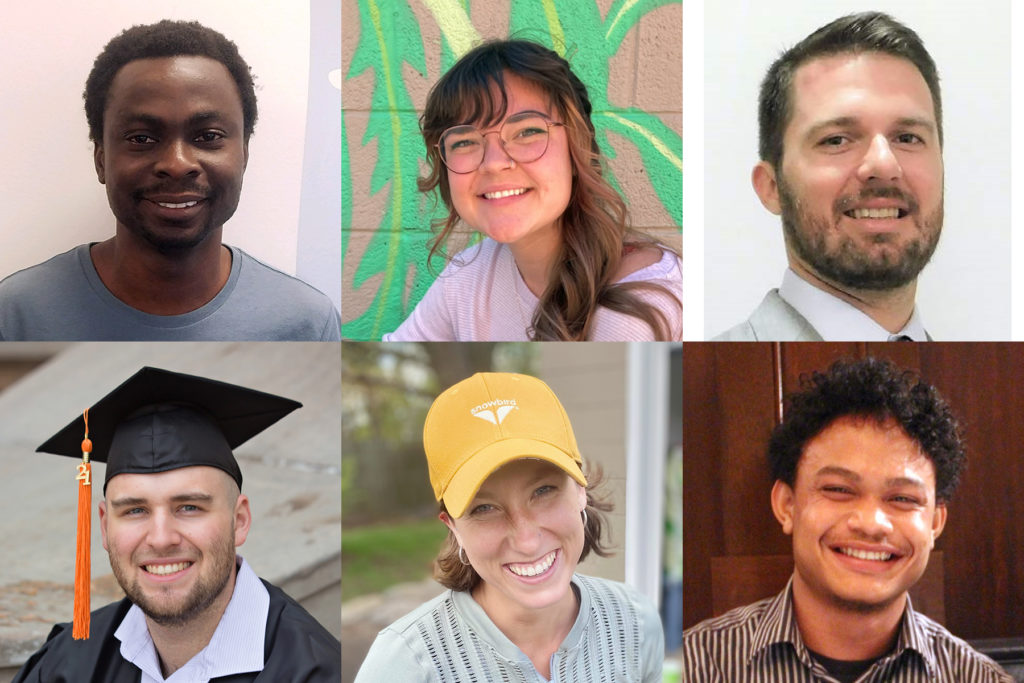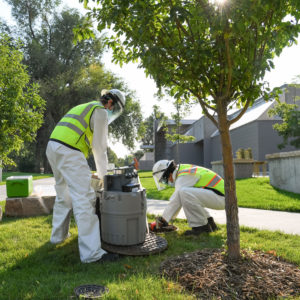
You may have seen them at sewer access points around campus, dressed in full Tyvek suits, fishing for wastewater samples to be tested for the virus that causes COVID-19. A crew of seven students worked early mornings and weekends, in all sorts of weather, to help keep Colorado State University’s campus open throughout the academic year.
And not one of them thought it was a “crappy” job.
“It was really exciting knowing I was going to be able to help my community through this work,” said Madison Jara, a member of the wastewater sampling team who earned her degree in environmental engineering in December. “Being on this project reinforces my passion of using engineering and research to benefit the community around me.”
Though the job was labor-intensive and tiring, Jara said working with incredible people was one of the best parts. “Working on this small team showed me that being surrounded by dedicated and caring people truly makes the world go around!”
That team included Temitope (Tope) Adeniji, Tom Anderson, Alan Martuch, Jack Miera, Abbie Modafferi and Nick Mohammed, and was supervised by Susan De Long, an associate professor in the Department of Civil and Environmental Engineering, and Susanne Cordery, an environmental engineer with CSU Facilities Management.
De Long and Cordery’s wastewater sampling team was in the field six days a week and worked every weekend. They even worked a 12-hour shift during a blizzard.
“These students embody the ethos of our University and stepped up in the time of crisis and made sacrifices to help protect our community,” De Long said.
The students’ dedication and desire to help were shared by many at the University. De Long and Cordery’s team handed off the samples they collected to Carol Wilusz’ lab, where her technicians also worked long hours, searching for viral signals in wastewater from campus as well as 21 other sites around the state of Colorado.
“Despite the unsocial and long hours, and the liters of sewage they have to process, this team lives by the values of our University daily,” said Wilusz, a professor and RNA biologist in the Department of Microbiology, Immunology and Pathology. “They are grateful for the opportunity to serve our CSU and Colorado communities.”
Within 24 hours of receiving samples, technicians August Luc and Jim Huang; graduate students Jorge Chavez, Alexa Doyle and Luke Hampton; and recent addition to the team, Phil Fox deliver valuable data that informs public health decisions on campus and across the state.
Protecting our campus community
The Office of the Vice President for Research supported development of CSU’s wastewater testing program, which became an important part of the University’s – and Colorado’s – pandemic response. An infected person can shed the virus in their feces before experiencing symptoms, making wastewater testing an early warning system.
By monitoring 17 sewage sites on campus that could be linked to a specific residence hall or small group of buildings, decision-makers were able to focus limited resources where they were needed most. Early in fall semester, before saliva screening made campus-wide testing cost-effective, University leadership used wastewater data to identify populations for the more expensive nasal swab testing.
The five-day quarantine of Braiden and Summit Halls in September was an example of using wastewater data to suppress a potential outbreak. A high concentration was detected for those buildings, all of the buildings’ residents were tested, and as soon as the positive cases were identified and isolated, the quarantine was lifted.
Though wastewater epidemiology is an established practice, applying it to this smaller scale on a building-by-building basis was new territory, and it took some time for CSU’s scientists and leaders to understand when the viral signal warranted action. As they became more familiar with variation in the signal, they were able to avoid further mass quarantines.
“That was the challenge of the pandemic is that there was no blueprint to follow,” said Heather Pidcoke, chief medical research officer and pandemic Rapid Response Team leader. “You had to do it by trial and error.”
An integrated approach
CSU’s pandemic response included personnel from across campus and the entire student body. Pidcoke and Vice President for Research Alan Rudolph, who together led CSU’s Rapid Response Team, credit the University’s integrated approach for the successful conclusion to a challenging year.

“I was looking for a way to contribute towards keeping people safe during the pandemic, so I jumped at the opportunity [to be involved in the wastewater sampling program]. – Temitope (Tope) Adeniji, electrical engineering master’s student
“I am proud to know that my job has had a direct impact on keeping CSU open and healthy.” – Jack Miera, graduated in May with a degree in chemical and biological engineering
“I am so proud to have worked on a project supervised by women! They have all inspired and assured me to pursue a career in science.” – Abbie Modafferi, recent toxicology master’s graduate
“I think all of us feel really proud to be part of a community where we were able to maintain the campus open to in-person classes all the way to the date we had targeted,” Pidcoke said. “We all recognize that no one person or strategy can be responsible for that. We had many, many layers of people working together.”
Those layers included scientists developing testing programs, technicians administering tests, the public health team conducting contact tracing, Housing & Dining Services leadership acting on wastewater data, Facilities Management staff ensuring buildings were clean and safe, communicators educating the community about health guidelines and keeping everyone informed of the rapidly evolving situation, and students following public health guidance.
“For a land-grant university like Colorado State, it once again showed the underlying culture and passion here that we try to make a difference – and we try to do that in our everyday work, but when we’re hit with a disaster, we come together and effectively work together,” Rudolph said.
Shifting strategy
The CSU System has mandated COVID vaccines for the entire CSU community by fall semester. Once vaccinated, faculty, students and staff are not required to submit to weekly saliva screening.
CSU leadership will remain vigilant as campus returns to normal, and wastewater surveillance as an early warning system will continue to be part of their strategy. A viral spike in the wastewater stream could indicate a mutation of the virus that escaped the vaccine, and having that information early will help with getting it under control quickly.
“The nice thing about micro-surveillance is you actually have a manageable number of people to develop a plan around,” Pidcoke said.